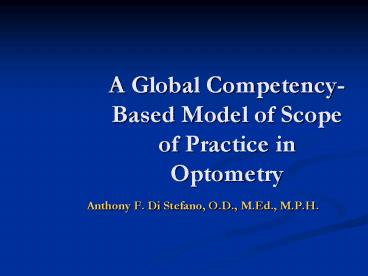A Global CompetencyBased Model of Scope of Practice in Optometry - PowerPoint PPT Presentation
1 / 28
Title:
A Global CompetencyBased Model of Scope of Practice in Optometry
Description:
A Global Competency-Based Model of Scope of Practice in Optometry ... interpupillary distance, lid eversion, photography, diagnostic pharmaceuticals, tear dynamics. ... – PowerPoint PPT presentation
Number of Views:156
Avg rating:3.0/5.0
Title: A Global CompetencyBased Model of Scope of Practice in Optometry
1
A Global Competency-Based Model of Scope of
Practice in Optometry
- Anthony F. Di Stefano, O.D., M.Ed., M.P.H.
2
Committee
- Dr. Norman Wallis, Chair
- Dr. Robert Chappell
- Dr. Patricia Kiely
- Dr. Thomas Lawless
- Dr. Leon Gross (Consultant)
- Dr. Anthony Di Stefano (WCO)
3
Introduction
- WTO and GATS
- MRAs
- Optometric initiative
- ARBO and WCO collaboration
- WCO and ARBO committee
- International Advisory Group on Optometric
Competencies (IAGOC) (December 2003)
4
WCO Concept of Optometry Statement
- Optometry is a healthcare profession that is
autonomous, educated, and regulated
(licensed/registered), and optometrists are the
primary healthcare practitioners of the eye and
visual system who provide comprehensive eye and
vision care, which includes refraction and
dispensing, detection/diagnosis and management of
disease in the eye, and the rehabilitation of
conditions of the visual system - Developed Paris 1992
- Approved Venice 1993
5
Background/Prior Work
- Do not reinvent the wheel
- Model must address variations in scope of
practice - Controversial topic for some
- ECOO European Diploma recognized diversity in
region with 3 stages
6
ECOOs European Diploma Structure
- Optical Technology (lab work and dispensing)
- Vision Care (refraction, BV, CLs)
- Ocular Disease ( systemic) (detection/diagnosis
and management) - Different words used for political reasons
7
10 years later
- Global vs. Regional
- Therapeutic use of drugs now common in some
countries (Australia, Canada, Nigeria, UK, USA,
etc) - Need an additional stage
- Evolutionary approach
8
Categories of Service
- Optical Technology Services
- Visual Function Services
- Ocular Diagnostic Services
- Ocular Therapeutic Services
9
Optical Technology Services
- Management and dispensing of ophthalmic lenses,
ophthalmic frames and other ophthalmic devices
that correct defects of the visual system
10
Visual Function Services
- Optical Technology Services
- and/plus
- Investigation, examination, measurement,
diagnosis and correction/management of defects of
the visual system
11
Ocular Diagnostic Services
- Optical Technology Services
- and/plus
- Visual Function Services
- and/plus
- Investigation, examination and evaluation of the
eye and adnexa, and associated systemic factors
to detect, diagnose and manage disease
12
Ocular Therapeutic Services
- Ocular Technology Services
- and/plus
- Visual Function Services
- and/plus
- Ocular Diagnostic Services
- and/plus
- Use of pharmaceutical agents and other procedures
to manage ocular conditions/disease
13
Competency Statements
- Work in Australia, Canada, UK, California
- IAGOC recommended Australian competency
statements and system - Allocate across 4 stages
14
Optometrists Association Australia
- Developed system of competency statements (1993,
1997, 2000) - Tracked evolution of profession in one country
- Has been applied in other countries, e.g., Norway
15
The System
- Units 6 major components of activities within
profession - Elements sub-divisions of units
- Performance criteria accompany elements,
evaluative statements - Indicators measurable and observable features
of performance criteria (refinement for more
specificity and assessment)
16
The Units
- 1 Professional and clinical responsibilities
- 2 Patient history
- 3 Patient examination
- 4 Diagnosis
- 5 Patient management
- 6 Recording of clinical data
17
Unit 1 Professional and Clinical
Responsibilities
- Elements
- Ensures that optometric knowledge, clinical
expertise and equipment remain current. - Practices without the need for supervision
- Acts in accordance with the standards of behavior
of the profession. - Provides advice and information to patients and
others.
18
Unit 2 Patient History
- Elements
- Communicates with the patient.
- Makes general observations of patient
- Obtains the case history.
- Obtains and interprets patient information from
other professionals.
19
Unit 3 Patient Evaluation
- Elements
- Formulates an examination plan
- Implements examination plan
- Assesses the ocular adnexae and the eye
- Assesses central and peripheral sensory visual
function and the integrity of the visual
pathways. - Assesses refractive status.
- Assesses oculomotor and binocular function.
20
Unit 4 Diagnosis
- Elements
- Interprets and analyses findings to establish a
diagnosis or diagnoses.
21
Unit 5 Patient Management
- Elements
- Designs a management plan for each patient and
implements the plan agreed to with the patient. - Prescribes spectacles
- Prescribes contact lenses
- Prescribes low vision devices.
22
Unit 6 Recording of Clinical Data
- Elements
- Ensures that data is organized in a legible,
secure, accessible, permanent and unambiguous
manner. - Maintains confidentiality of patient records.
23
Allocation to Categories
- Prefixes for each each Stage
- Optical technology -OT
- Visual function - VF
- Ocular diagnostic - ODx
- Ocular therapeutic OTx
- Denote specific meaning of performance criteria
- When meaning common across stages, arrow
- When no comparable meaning, blank
24
The System
- Units 6 major components of activities within
profession - Elements sub-divisions of units
- Performance criteria accompany elements,
evaluative statements - Indicators measurable and observable features
of performance criteria (refinement for more
specificity and assessment)
25
Example Allocation of System
- UNIT 3 PATIENT EXAMINATION
- Element
- 3.3 Assesses the ocular adnexae and the eye.
- Performance Criterion
- 3.3.1 The structure and health of the ocular
adnexae and their ability to function are
assessed. - Indicators
- Assessment of skin lesions, conjunctiva, lids,
lashes, puncta, Meibomian glands. Screening for
disease macro-observation, slit lamp
biomicroscopy, loupe, interpupillary distance,
lid eversion, photography, diagnostic
pharmaceuticals, tear dynamics.
26
Example 1
27
Example 2
28
Example 3































